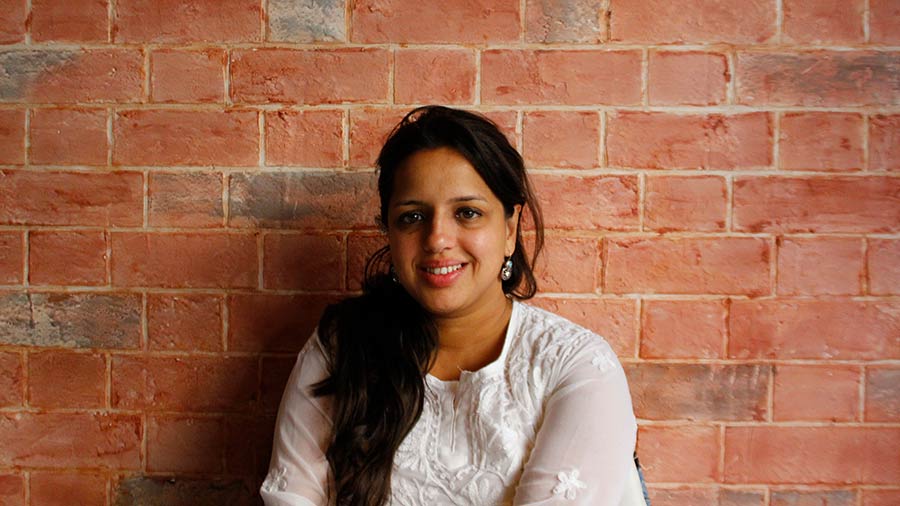“Kolkata is organised chaos,” observed Sreoshy Banerjea, during her first visit to the city since 2014, a city where she spent a part of her formative years and also where she got married. An urban designer who is currently the executive director of the New York City Public Design Commission, Sreoshy went on a mini-tour of Kolkata on December 23, arranged by My Kolkata. Joining her were her husband Roni Mazumdar, the champion of Indian cuisine in the US and the owner of six Indian restaurants in New York, and Iftekhar Ahsan, the general manager of Calcutta Bungalow and the founder of Calcutta Walks. As someone who analyses cityscapes and architecture for a living and is responsible in her own way for the look and feel of present-day New York, Kolkata managed to take Sreoshy by surprise. Mostly mild, and in a good way.
The ‘hybridised spirit’ of Calcutta Bungalow
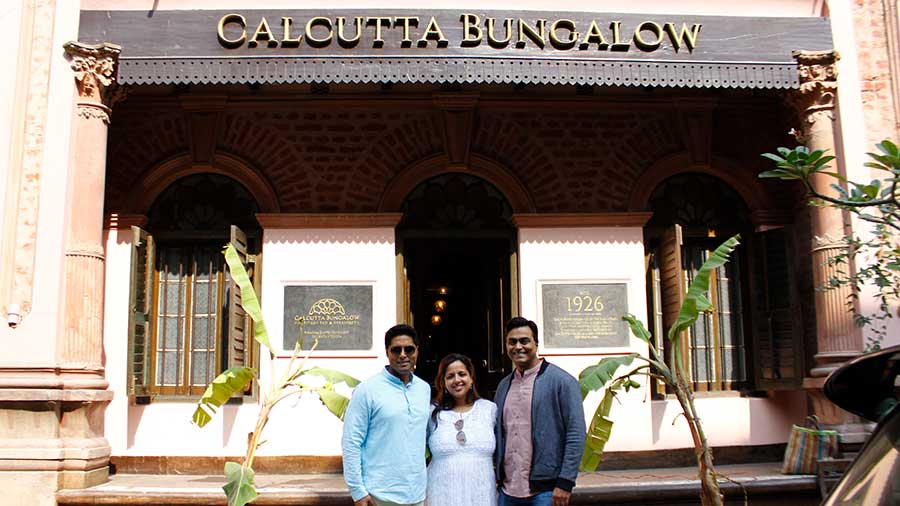
(L-R): Roni Mazumdar, Sreoshy Banerjea and Iftekhar Ahsan outside Calcutta Bungalow on Fariapukur’s Radha Kanta Jew Street
On the kind of winter morning that must have felt like a regular summer day in NYC, Sreoshy and Roni inaugurated their tour by arriving at Calcutta Bungalow on Fariapukur’s Radha Kanta Jew Street, where they were greeted by Iftekhar. Sreoshy was immediately struck by the “attention to detail” at the boutique hotel that used to be a 1920s townhouse. “I love how the place has retained the original splendour of what it was while also revamping and modernising itself through a careful curation of artefacts. I was particularly impressed by the courtyard and the stairs. The little touches, such as the vintage switchboards and the tables made from window shutters, were refreshing and suggestive of a hybridised spirit,” said Sreoshy.
“It reminded me of an era we need to restore in Kolkata. As a space, it celebrates what a home is meant to be, organic and imperfect,” added Roni. As Iftekhar took Sreoshy and Roni around Calcutta Bungalow, explaining how he and his team designed and decorated the place, the NYC couple were delighted to take in the essence of north Kolkata through its sights, sounds and smells. “The fact that you can smell the dhup (incense), see a crow cawing and hear the sound of the morning pujo next door is what authentic community living is all about,” remarked Sreoshy.
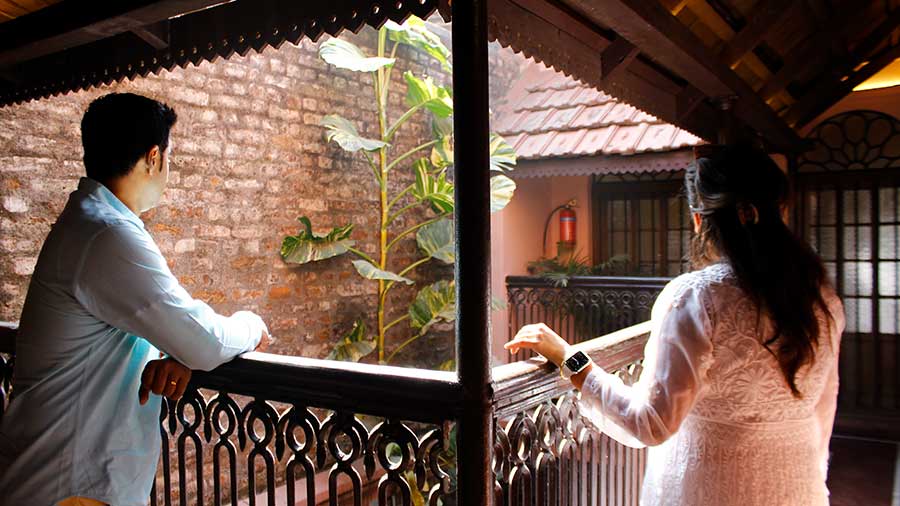
Roni and Sreoshy take a moment to appreciate their surroundings at Calcutta Bungalow
Having explored the nooks and corners of a hotel “where we’d love to stay with our kids at some point”, Sreoshy and Roni joined Iftekhar for a classic Bengali breakfast — Luchi, Aloor Dom, freshly cut fruits and Daaber Jol. “Coming out of the Kolkata airport felt different this time,” admitted Sreoshy. “We weren’t inundated with hawkers and peddlers. Everything seemed more structured and Kolkata felt a lot cleaner. Then, we went to New Market and I could relate more with the Kolkata I knew!”
“We should try to position Kolkata as a boutique city. We needn’t be the boldest, the largest or the grandest in the country. But we can be small, quaint and cute, standing out in our own way, learning from cities like Hanoi and Bali,” suggested Iftekhar.
Gradually, the breakfast conversation segued from Kolkata’s civic and architectural promise to Robert Moses, an influential American urban planner in the 20th century, via Roni’s food journey, which always makes for an intriguing recollection.
Mitra Bari to Jorasanko Daw Bari
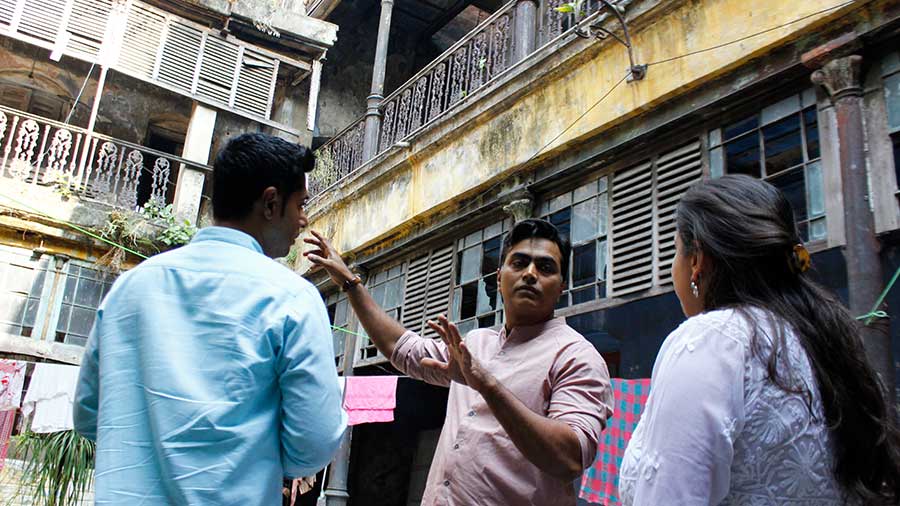
Iftekhar talks about the history of Shyampukur’s Mitra Bari to Roni and Sreoshy
Next stop was the Mitra Bari on Shyampukur Street, near Hatibagan. Built sometime in the 19th century, the dilapidated building has now been partitioned in two, with one of the sections expecting renovation. “It’s such a peaceful place, I wish there was a Landmarks Preservation Committee or something of that sort that could look after this site,” said Sreoshy. Iftekhar went on to narrate how the property has been certified as Grade-II heritage, which means that its facade, already falling apart, can only be altered but not destroyed and rebuilt altogether. “In New York, the local community is extremely passionate about their buildings… they’ll defend their heritage ferociously,” quipped Roni, just after Iftekhar had outlined how local promoters and builders can often cajole and coax their way to doing whatever they pleased with vulnerable buildings like the Mitra Bari.
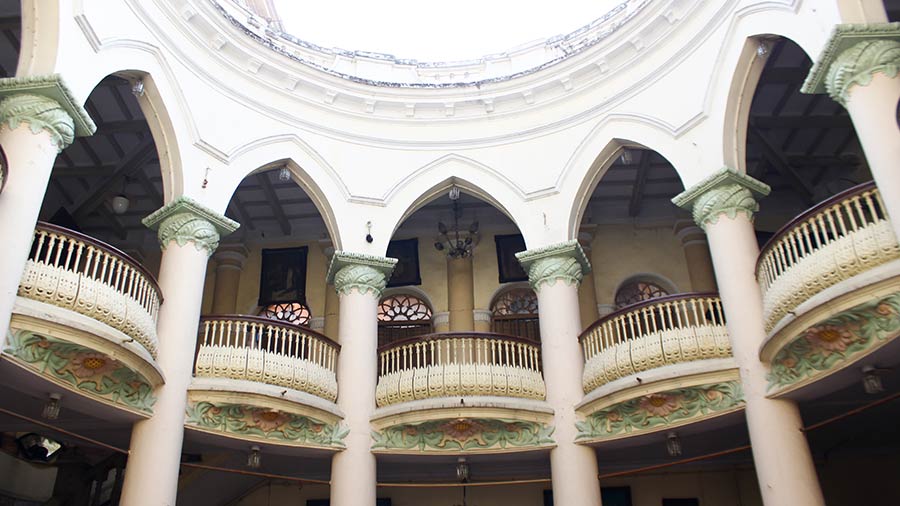
The Dao Rajbari in Jorasanko, resembling an opera house in its structure
From the decadence in Shyampukur, the tour moved on to the quiet elegance of the Daw Bari in Jorasanko, which, according to Sreoshy, carried “strong European and Gothic influences”. Fashioned in a layout that seems to (unconsciously) resemble an opera house, the ancient building was occupied solely by its caretaker when Sreoshy, Roni and Iftekhar came calling. “It’s such a shame that people don’t live here all year around, although I can imagine how the entire place comes to life during occasions such as Durga Puja,” reflected Sreoshy, who deemed the colour combination of green and white to be distinctly Italian, even as she acknowledged the quintessential Bengali motifs through the iconography of the palm trees and the presence of the alpana. “There’s a paradox running through the heart of this building. One can easily recognise that it’s special, but at the same time, not enough is being done to arrest its decline,” lamented Roni, while sampling tiles that had cracked and walls where the paint had begun to peel off.
Bow Barracks most similar to NYC in Kolkata
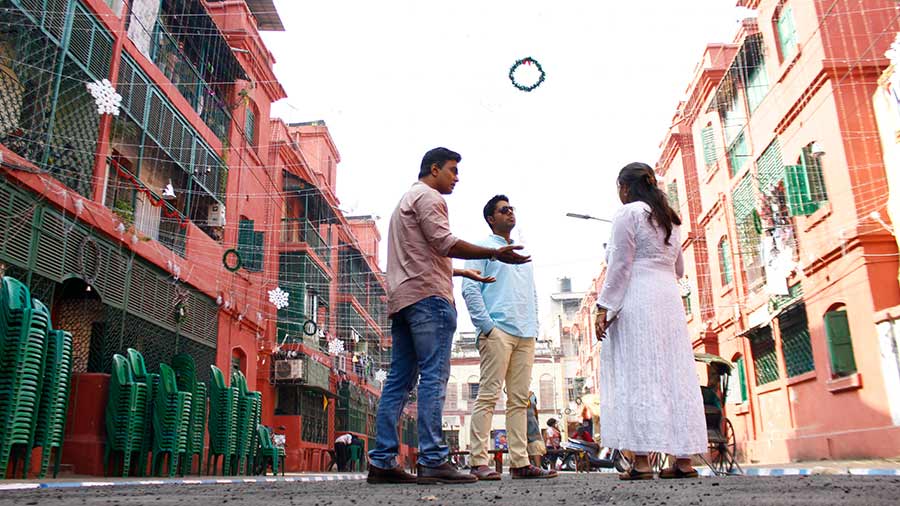
The tour arrives at Bow Barracks, decked up especially for Christmas and New Year
As afternoon approached, the group headed to its penultimate destination, a decked-up Bow Barracks, where Iftekhar gave a masterclass in the history and context of the place, sketching an intricate picture of how one of the primary hubs of the Anglo-Indian community in Kolkata came into being with its famous red-brick buildings. “Of all the places I’ve been to in the last few days, this one reminds me the most of New York. There seems to be a masterplan, a consistency in the architectural approach that emanates a feeling of urbanity. The streets are spacious and the sidewalks are walkable. I like how people can stand in the middle of the street (normal traffic was blocked on account of Christmas and New Year celebrations) and just take in the surroundings. I wish Kolkata had more places like this,” said Sreoshy.
Earlier, Sreoshy had contrasted what she saw of streetside commerce in Kolkata from her car with what New Yorkers are aspiring for themselves: “It’s interesting how there are essentially three layers of shopping happening on the streets of Kolkata. There’s the glassdoor retail shopping to start with and then there are the hawkers selling goods on the footpaths. And then, in between those layers, is a third layer where customers are jostling their way through and picking stuff up from makeshift stores even though there’s little room to walk. In New York, we’ve been wondering how to manage an extra foot of space on our streets to get people to interact freely. And that alone takes hours of discussions, policies and what not. While over here in India, the public realm somehow manages itself. ”
‘More top-down initiatives; a greater enthusiasm on the part of the people’

Roni and Sreoshy after a hearty lunch at Peter Hu?
After more than four hours of driving, walking, watching and analysing, the tour reached Park Street. Before checking in for lunch, Sreoshy and Roni had a brief encounter with the thoroughfares of Park Street, with Roni particularly inquisitive of eateries, cafes and restaurants that had come up recently. Eventually, it was time for the meal of the day at Peter Hu?, where Siddharth Kothari had organised a sumptuous lunch, involving soups, baos, dim sums, noodles and a whole lot more. “It’s quite a feat pulling off such a menu and having so many items,” said Roni – of ‘Michelin’ Semma fame – as both he and Sreoshy enjoyed some of Kolkata’s finest Asian food.
“Kolkata is always about nostalgia for me, but I really hope that the city doesn’t take itself for granted, that it keeps moving forward,” said Roni in his parting comments. As for Sreoshy, while she wished that “the city had more open spaces and playgrounds”, she also sensed that Kolkata and its contours are changing. “It’s not the Kolkata I had left behind, and I’m glad to have experienced some of the new things that make the city what it is today. With more top-down initiatives and a greater enthusiasm on the part of Kolkatans, the city can continue blossoming,” summed up Sreoshy. Will she be back to help with that at some point? “I certainly hope so,” she smiled.
